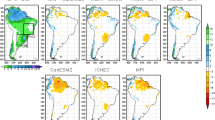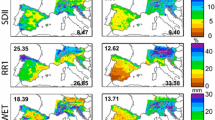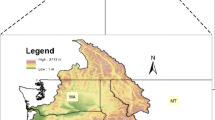Abstract
Regional climate models (RCMs) can simulate heavy precipitation more accurately than general circulation models (GCMs) through more realistic representation of topography and mesoscale processes. Analogue methods of downscaling, which identify the large-scale atmospheric conditions associated with heavy precipitation, can also produce more accurate and precise heavy precipitation frequency in GCMs than the simulated precipitation. In this study, we examine the performances of the analogue method versus direct simulation, when applied to RCM and GCM simulations, in detecting present-day and future changes in summer (JJA) heavy precipitation over the Midwestern United States. We find analogue methods are comparable to MERRA-2 and its bias-corrected precipitation in characterizing the occurrence and interannual variations of observed heavy precipitation events, all significantly improving upon MERRA precipitation. For the late twentieth-century heavy precipitation frequency, RCM precipitation improves upon the corresponding driving GCM with greater accuracy yet comparable inter-model discrepancies, while both RCM- and GCM-based analogue results outperform their model-simulated precipitation counterparts in terms of accuracy and model consensus. For the projected trends in heavy precipitation frequency through the mid twenty-first century, analogue method also manifests its superiority to direct simulation with reduced intermodel disparities, while the RCM-based analogue and simulated precipitation do not demonstrate a salient improvement (in model consensus) over the GCM-based assessment. However, a number of caveats preclude any overall judgement, and further work—over any region of interest—should include a larger sample of GCMs and RCMs as well as ensemble simulations to comprehensively account for internal variability.




Similar content being viewed by others
References
Bosilovich MG, Lucchesi R, Suarez M (2016) MERRA-2: file specification. GMAO Office Note No. 9 (Version 1.1), p 73. http://gmao.gsfc.nasa.gov/pubs/office_notes
Chan SC, Kendon EJ, Fowler HJ, Blenkinsop S, Ferro CAT, Stephenson DB (2013) Does increasing the spatial resolution of a regional climate model improve the simulated daily precipitation? Clim Dyn 41(5–6):1475–1495
Chan SC, Kendon EJ, Fowler HJ et al (2014) The value of high-resolution Met Office regional climate models in the simulation of multihourly precipitation extremes. J Clim 27:6155–6174
Chen C, Knutson T (2008) On the verification and comparison of extreme rainfall indices from climate models. J Clim 21:1605–1621
Christensen JH, Carter TR, Rummukainen M, Amanatidis G (2007) Evaluating the performance and utility of regional climate models: the PRUDENCE project. Clim Chang 81(Suppl 1):1–6. https://doi.org/10.1007/s10584-006-9211-6
Chylek P, Li J, Dubey MK, Wang M, Lesins G (2011) Observed and model simulated 20th century Arctic temperature variability: Canadian Earth System Model CanESM2. Atmos Chem Phys Discuss 11:22893–22907
Colle BA, Booth JF, Chang EKM (2015) A review of historical and future changes of extratropical cyclones and associated impacts along the US East Coast. Curr Clim Change Rep 1:125–143. https://doi.org/10.1007/s40641-015-0013-7
Collins WD, Bitz CM, Blackmon ML, Bonan GB, Bretherton CS, Carton JA, Chang P, Doney SC, Hack JJ, Henderson TB, Kiehl JT, Large WG, McKenna DS, Santer BD, Smith RD (2006) The community climate system model Version 3 (CCSM3). J Clim 19:2122–2143
Covey C, AchutaRao KM, Lambert SJ, Taylor KE (2000) Intercomparison of present and future climates simulated by coupled ocean–atmosphere GCMs. Program for Climate Model Diagnosis and Intercomparison Report #66, Lawrence Livermore National Laboratory UCRL-ID-140325
Dai A (2006) Precipitation characteristics in eighteen coupled cli- mate models. J Clim 19:4605–4630
DeAngelis AM, Broccoli AJ, Decker SG (2013) A comparison of CMIP3 simulations of precipitation over North America with observations: Daily statistics and circulation features accompanying extreme events. J Clim 26:3209–3230
Delworth T et al (2006) GFDL’s CM2 global coupled climate models—Part 1: formulation and simulation characteristics. J Clim 19:643–674
Deser C, Knutti R, Solomon S, Phillips AS (2012) Communication of the role of natural variability in future North American climate. Nat Clim Change 2(11):775–779
Di Luca A, de Elia R, Laprise R (2012) Potential for added value in precipitation simulated by high-resolution nested Regional Climate Models and observations. Clim Dyn 38:1229–1247
Donner LJ et al (2011) The dynamical core, physical parameterizations, and basic simulation characteristics of the atmospheric component AM3 of the GFDL global coupled model CM3. J Clim 24:3484–3519
Feser F, Rockel B, von Storch H, Winterfeldt J, Zahn M (2011) Regional climate models add value to global model data: a review and selected examples. Bull Am Meteor Soc 92:1181–1192
Flato GM, Boer GJ, Lee WG, McFarlane NA, Ramsden D, Reader MC, Weaver AJ (2000) The Canadian centre for climate modeling and analysis global coupled model and its climate. Clim Dyn 16:451–467
Gao X, Schlosser CA, Xie P, Monier E, Entekhabi D (2014) An analogue approach to identify heavy precipitation events: evaluation and application to CMIP5 climate models in the United States. J Clim 27:5941–5963
Gao X, Schlosser CA, O’Gorman PA, Monier E, Entekhabi D (2017) Twenty-first-century changes in US regional heavy precipitation frequency based on resolved atmospheric patterns. J Clim 30:2501–2521
Gent PR (2011) The community climate system model version 4. J Clim 24:4973–4991
Giorgi F, Gutowski WJ Jr (2015) Regional dynamical downscaling and the CORDEX initiative. Annu Rev Env Resour 40:467–490
Giorgi F, Coppola E, Raffaele F et al (2014) Changes in extremes and hydroclimatic regimes in the CREMA ensemble projections. Clim Change 125:39–51
Giorgi F, Torma C, Coppola E et al (2016) Enhanced summer convective rainfall at Alpine high elevations in response to climate warming. Nat Geosci 9:584–589
Grell GA, Devenyi D (2002) A generalized approach to parameterizing convection combining ensemble and data assimilation techniques. Geophys Res Lett 29:1693–1697
Grell G, Dudhia J, Stauffer D (1995) A description of the Fifth-Generation Penn State/NCAR Mesoscale Model (MM5) NCAR Technical Note, NCAR/TN-398 + STR
Griffies SM, Winton M, Donner LJ, Horowitz LW, Downes SM, Farneti R, Gnanadesikan A, Hurlin WJ, Lee H, Liang Z, Palter JB, Samuels BL, Wittenberg AT, Wyman BL, Yin J, Zadeh N (2011) The GFDL CM3 coupled climate model: characteristics of the ocean and sea ice simulations. J Clim 24:3520–3544
Grotjahn R (2011) Identifying extreme hottest days from large scale upper air data: a pilot scheme to find California Central Valley summertime maximum surface temperatures. Clim Dyn 37:587–604
Gutowski WJ Jr, Willis SS, Patton JC, Schwedler BRJ, Arritt RW, Takle ES (2008) Changes in extreme, cold-season synoptic precipitation events under global warming. Geophys Res Lett 35:L20710. https://doi.org/10.1029/2008GL035516
Gutowski WJ Jr, Giorgi F, Timbal B, Frigon A, Jacob D, Kang HS, Raghavan K, Lee B, Lennard C, Nikulin G, O’Rourke E, Rixen M, Solman S, Stephenson T, Tangang F (2016) WCRP COordinated Regional Downscaling EXperiment (CORDEX): a diagnostic MIP for CMIP6. Geosci Model Dev 9:4087–4095. https://doi.org/10.5194/gmd-9-4087-2016
Hawkins E, Sutton R (2009) The potential to narrow uncertainty in regional climate predictions. Bull Am Meteorol Soc 90:1095–1107
Hawkins E, Sutton R (2011) The potential to narrow uncertainty in projections of regional precipitation change. Clim Dyn 37:407–418
Hewitson BC, Crane RG (2006) Consensus between GCM climate change projections with empirical downscaling: precipitation downscaling over South Africa. Int J Climatol 26:1315–1337
Higgins RW, Shi W, Yarosh E, Joyce R (2000) Improved US Precipitation Quality Control System and Analysis. NCEP/ Climate Prediction Center ATLAS No. 7, National Centers for Environmental Prediction, Climate Prediction Center, Camp Springs, Maryland. Available at http://www.cpc.ncep.noaa.gov/research_papers/ncep_cpc_atlas/7/index.html. Data is available at http://www.cdc.noaa.gov/cdc/data.unified.html
Hutchinson MF (1995) Interpolating mean rainfall using thin plate smoothing splines. INT J Geogr Inf Syst 9:385–403
Jones R, Noguer M, Hassell D, Hudson D, Wilson S, Jenkins G, Mitchell J (2004) Generating high resolution climate change scenarios using PRECIS. Met Office Hadley Centre, Exeter, p 40
Kalognomou E, Lennard C, Shongwe M et al (2013) A diagnostic evaluation of precipitation in CORDEX models over Southern Africa. J Climate 26:9477–9506
Kanamitsu M, Ebisuzaki W, Woollen J, Yang S-K, Hnilo JJ, Fiorino M, Potter GL (2002) NCEP-DOE AMIP-II Reanalysis (R-2). Bull Am Meteor Soc 83:1631–1643
Kawazoe S, Gutowski WJ (2013a) Regional, very heavy daily precipitation in CMIP5 simulations. J Hydrometeor 14:1228–1242
Kawazoe S, Gutowski WJ (2013b) Regional, very heavy daily precipitation in NARCCAP simulations. J Hydrometeor 14:1212–1227
Li F, Collins WD, Wehner MF, Williamson DL, Olson JG, Algieri C (2011) Impact of horizontal resolution on simulation of precipitation extremes in an aqua-planet version of Community Atmospheric Model (CAM3). Tellus A 63:884–892
Lucas-Picher P, Laprise R, Winger K (2017) Evidence of added value in North American regional climate model hindcast simulations using ever-increasing horizontal resolutions. Clim Dyn 48:2611–2633
Mearns LO, Gutowski WJ, Jones R, Leung L-Y, McGinnis S, Nunes AMB, Qian Y (2009) A regional climate change assessment program for North America. EOS 90:311–312
Meehl GA, Covey C, Taylor KE, Delworth T, Stouffer RJ, Latif M, McAvaney B, Mitchell JF (2007) The WCRP CMIP3 multimodel dataset: a new era in climate change research. Bull Am Meteor Soc 88:1383–1394
Mishra V, Kumar D, Ganguly AR et al (2014) Reliability of regional and global climate models to simulate precipitation extremes over India. J Geophys Res Atmos 119:9301–9323
Molod A, Takacs L, Suarez M, Bacmeister J (2015) Development of the GEOS-5 atmospheric general circulation model: evolution from MERRA to MERRA2. Geosci Model Dev 8:1339–1356
Monier E, Gao X (2015) Climate change impacts on extreme events in the United States: an uncertainty analysis. Clim Change 131:67–81
Monier E, Gao X, Scott JR, Sokolov AP, Schlosser CA (2015) A framework for modeling uncertainty in regional climate change. Clim Change 131:51–66
Music B, Caya D (2007) Evaluation of the hydrological cycle over the Mississippi River Basin as simulated by the Canadian regional climate model (CRCM). J Hydrometeor 8:969–988
Nakic´enovic´ N, Swart R (eds) (2000) Special report on emissions scenarios: a special report of Working Group III on the Intergovernmental Panel on Climate Change. Cambridge University Press, Cambridge
Nikulin G, Jones C, Giorgi F et al (2012) Precipitation climatology in an ensemble of CORDEX-Africa regional climate simulations. J Clim 25:6057–6078
Paeth H, Hall NMJ, Gaertner MA et al (2011) Progress in regional downscaling of west African precipitation. Atmos Sci Lett 12:75–82
Poan ED, Gachon P, Laprise R, Aider R, Dueymes G (2017) Investigating added value of regional climate modeling in North American winter storm track simulations. Clim Dyn. https://doi.org/10.1007/s00382-017-3723-9
Prein AF, Holland GJ, Rasmussen RM et al (2013) Importance of regional climate model grid spacing for the simulation of heavy precipitation in the Colorado Headwaters. J Clim 26:4848–4857
Prein AF, Gobiet A, Truhetz H et al (2016) Precipitation in the EURO-CORDEX 0.11°°and 0.44° simulations: high resolution, high benefits? Clim Dyn 46:383–412
Rauscher SA, Coppola E, Piani C et al (2010) Resolution effects on regional climate model simulations of seasonal precipitation over Europe. Clim Dyn 35:685–711
Reichle R, Liu Q, Koster R, Draper C, Mahanama S, Partyka G (2017) Land Surface Precipitation in MERRA-2. J Clim 30:1643–1664
Seiler C, Zwiers FW, Hodges KI, Scinocca JF (2017) How does dynamical downscaling affect model biases and future projections of explosive extratropical cyclones along North America’s Atlantic coast? Clim Dyn https://https://doi.org/10.1007/s00382-017-3634-9
Šeparović L, Alexandru A, Laprise R et al (2013) Present climate and climate change over North America as simulated by the fifth-generation Canadian regional climate model. Clim Dyn 41:3167–3201
Singh D, Tsiang M, Rajaratnam B, Diffenbaugh NS (2013) Precipitation extremes over the continental United States in a transient, high-resolution, ensemble climate model experiment. J Geophys Res Atmos 118:7063–7086
Skamarock WC, Klemp JB, Dudhia J, Gill DO, Barker DM, Wang W, Powers JG (2005) A description of the advanced research WRF Version 2. NCAR Tech Notes-468 + STR http://www.mmm.ucar.edu/wrf/users/docs/arw_v2.pdf
Sriver RL, Forest CE, Keller K (2015) Effects of initial conditions uncertainty on regional climate variability: An analysis using a low-resolution CESM ensemble. Geophys Res Lett 42:5468–5476
Sun Y, Solomon S, Dai A, Portmann RW (2006) How often does it rain? J Clim 19:916–934
Taylor KE, Stouffer RJ, Meehl GA (2012) An overview of CMIP5 and the experiment design. Bull Am Meteor Soc 93:485–498
Torma CS, Giorgi F, Coppola E (2015) Added value of regional climate modeling over areas characterized by complex terrain—precipitation over the Alps. J Geophys Res Atmos 120:3957–3972
Uppala S, Dee D, Kobayashi D, Berrisford S, Simmons P A (2008) Towards a climate adapt assimilation system: status update of ERA- Interim. ECMWF Newslett 115:12–18
Wehner MF (2013) Very extreme seasonal precipitation in the NARCCAP ensemble: model performance and projections. Clim Dyn 40:59–80. https://doi.org/10.1007/s00382-012-1393-1
Wehner MF, Smith R, Duffy P, Bala G (2010) The effect of horizontal resolution on simulation of very extreme US precipitation events in a global atmosphere model. Clim Dyn 32:241–247. https://doi.org/10.1007/s00382-009-0656-y
Wilcox EM, Donner LJ (2007) The frequency of extreme rain events in satellite rain-rate estimates and an atmospheric general circulation model. J Clim 20(1):53–69
Acknowledgements
This work was funded by MacroSystems Biology Program Grant (NSF-AES EF#1137306) from National Science Foundation and An Integrated Framework for Climate Change Assessment (DE-FG02-94ER61937) from the Department of Energy. We acknowledge the modeling groups, the Program for Climate Model Diagnosis and Intercomparison (PCMDI), and the WCRP’s Working Group on Coupled Modeling (WGCM) for their roles in making available the WCRP CMIP5 multimodel dataset. We also thank the North American Regional Climate Change Assessment Program (NARCCAP) for providing the data used in this paper, the NOAA Climate Prediction Center for the global gridded precipitation observations, and the NASA Global Modeling and Assimilation Office for the MERRA-2 Reanalysis data.
Author information
Authors and Affiliations
Corresponding author
Rights and permissions
About this article
Cite this article
Gao, X., Schlosser, C.A. Mid-Western US heavy summer-precipitation in regional and global climate models: the impact on model skill and consensus through an analogue lens. Clim Dyn 52, 1569–1582 (2019). https://doi.org/10.1007/s00382-018-4209-0
Received:
Accepted:
Published:
Issue Date:
DOI: https://doi.org/10.1007/s00382-018-4209-0




